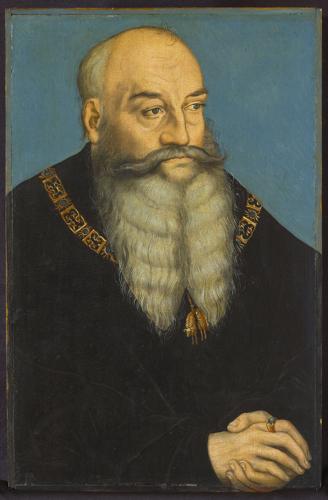
Courtesy of the Allentown Museum
The Allentown Art Museum will highlight the Portrait of George the Bearded, Duke of Saxony (ca. 1534) in a special exhibition. The 16th-century portrait attributed to Lucas Cranach the Elder and his workshop will go on display on Thursday, after a restitution claim was settled with the descendants of a German Jewish couple who fled the Nazis before the start of World War II. The painting will be included in a special display of works owned by Jewish families in Germany in the years leading up to the Second World War to illustrate the different trajectories of the artworks throughout the Nazi period. The installation will be on view August 29 through October 20, 2024, and it will include educational information about the Museum’s decision to deaccession the painting.
The Allentown Art Museum recently agreed to relinquish the painting following a claim made by the family of Henry and Hertha Bromberg, who fled Hamburg, Germany in 1938. The painting was purchased from a New York gallery in 1961 and has been on display at the museum ever since. “This work of art entered the market and eventually found its way to the museum only because Henry Bromberg fled persecution from Nazi Germany,” said the museum’s CEO and President, Max Weintraub.
As part of the settlement, the portrait will be sold at the Christie’s Old Masters sale in New York this January. The proceeds will be divided between the museum and the Bromberg heirs, although the details of the arrangement have not been disclosed.
The museum’s lawyer, Nick M. O’Donnell says that research could not establish the precise timing of the Cranach sale by the Brombergs, but “the larger context of the Brombergs’ flight from the Nazis and the sale of his collection along the way was morally compelling.” “That placed the sale among those transactions in the Nazi era that defy categorical description, and thus often elude easy solutions.” he said in The Art Law Report on Monday.
However, the museum says the agreement was reached in the spirit of the Washington Conference Principles on Nazi Confiscated Art, and with applicable guidance from the International Council of Museums (ICOM), the American Alliance of Museums (AAM), and the Association of Art Museum Directors (AAMD). The museum says the Pennsylvania Attorney General has approved its decision to deaccession the painting.
“We hope that this voluntary act by the Museum will inform and encourage similar institutions to reach a fair and just solution,” Weintraub says. Christie’s reportedly says it cannot yet give an accurate pre-auction valuation of the work since it is still determining the proper attribution of the painting. Marc Porter, chairman of Christie’s Americas, said in a statement to the New York Times that its research was “leading to a tentative conclusion that this was painted by Cranach with assistance from his workshop.” Cranach’s portrait of John Frederick I, Elector of Saxony, sold for $7.7 million in 2018. Another painting, attributed to Cranach and workshop, sold for about $1.1 million in 2009.
O’Donnell says Henry Bromberg’s father, Martin Bromberg, acquired the Cranach in October of 1917 and passed the Cranach to his son, who retained it in his house in Hamburg as late as 1935. The Bromberg’s son, Harald, emigrated to the United States in 1935, followed by their son Edgar one year later, and finally their youngest sons Gerhard and Oswald in 1938.
“While being persecuted and on the run from Nazi Germany, Henry and Hertha Bromberg had to part with their artworks by selling them through various art dealers, including the Cranach,” a lawyer for the Bromberg heirs, Imke Gielen, told the New York Times. O’Donnell says the Brombergs left Germany and arrived in Switzerland in early September of 1938. They eventually departed Europe from Le Havre, France en route to the United States on January 17, 1939.
The family says the Brombergs first settled in New Jersey before moving, several years later, to Pennsylvania (not far from Allentown) to be near one of their sons. “This makes the fair and just solution for the painting in the Allentown Art Museum particularly special,” they stated.
“The Nazis not only confiscated and stole property, but also forced victims to sell items at a fraction of their worth, pay exorbitant flight taxes, or abandon their homes and property when fleeing from the Third Reich,” Amineddoleh & Associates LLC wrote in 2019. “The toll of deprivation on such a massive scale is still felt many decades later.”
In this case, the members of the family “are pleased that another painting from [their] grandparents’ art collection was identified and are satisfied that the Allentown Art Museum carefully and responsibly checked the provenance of the portrait of George the Bearded, Duke of Saxony and the circumstances under which Henry and Hertha Bromberg had to part with it during the Nazi period.”